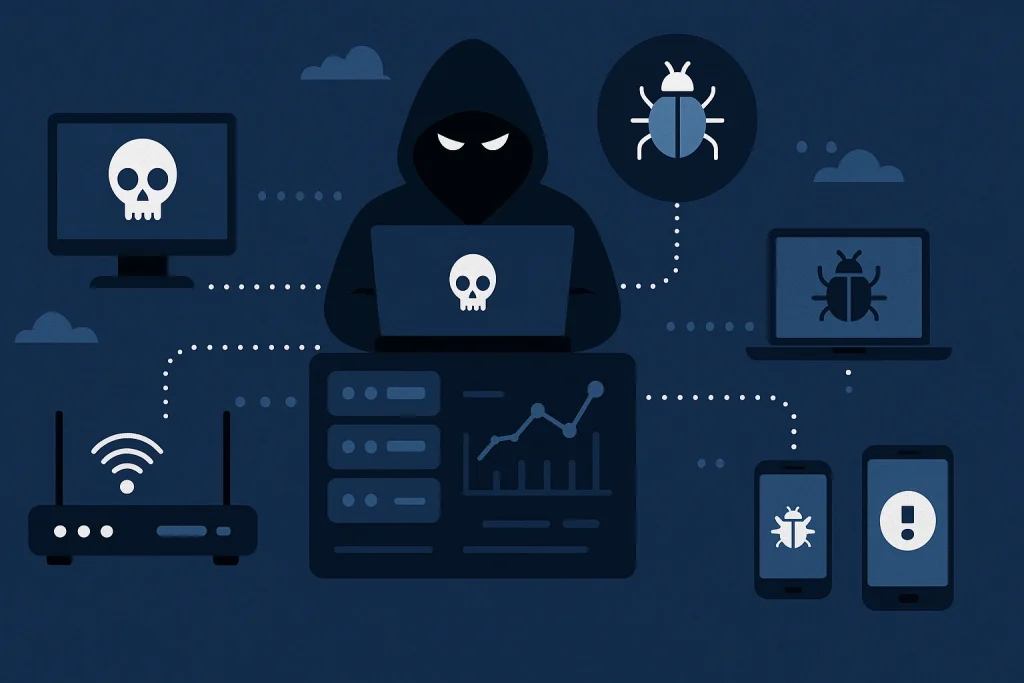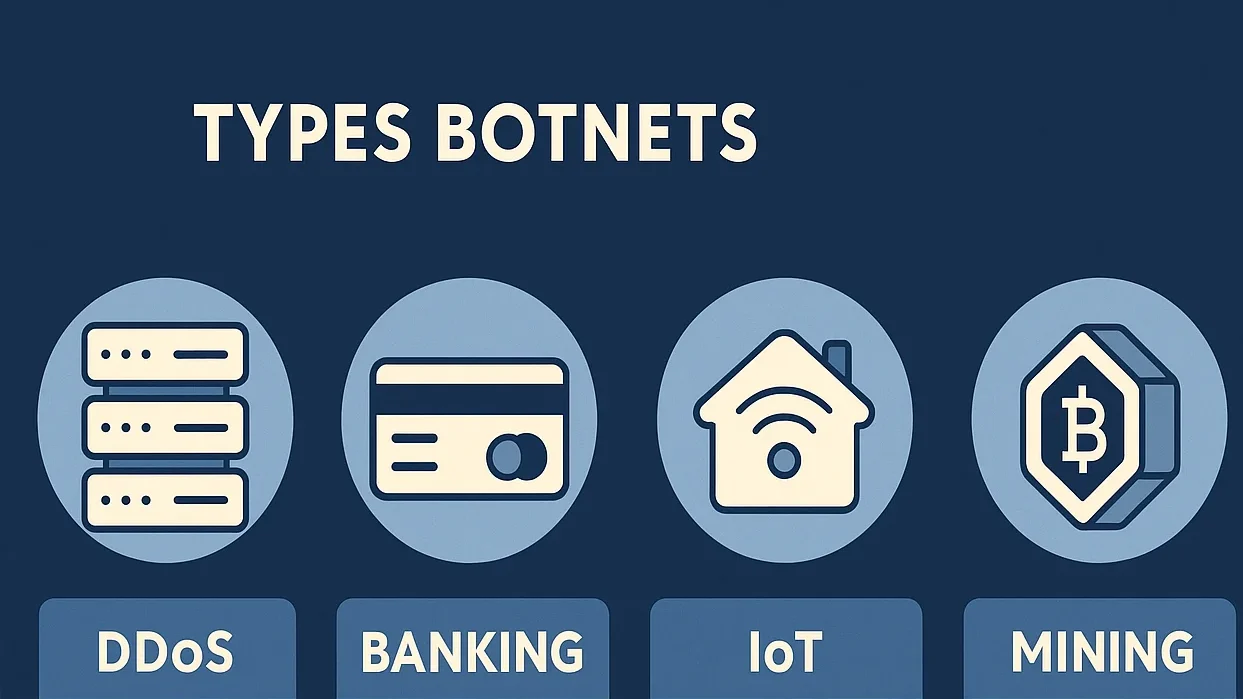If you’ve ever wondered how massive cyberattacks can take down websites, disrupt services, or steal data on a huge scale, the answer often lies in botnets. In cybersecurity, it represents a silent army of compromised devices controlled by attackers. These machines could be computers, smartphones, or even smart home gadgets. The frightening part? Victims rarely realize their devices are being used.
Understanding it is essential today. Attackers use them for everything from identity theft to financial scams. They also power some of the most dangerous modern crimes, including the spread of deepfakes, ransomware, and large-scale fraud. With rising cyber threats and advanced hacking tools, botnets remain one of the most destructive weapons in the digital battlefield.
What Is A Botnet?
it refers to a network of devices infected with malware and controlled remotely by attackers, often called “botmasters.” These devices—known as “bots” or “zombies”—work together without the owner’s knowledge. It is also called “robot networks,” “zombie networks,” or “malware armies.”
Breaking Down Botnet

A botnet is like an invisible army of infected devices. Each one looks normal to its owner but secretly follows commands from a remote attacker, carrying out large-scale attacks no single machine could achieve.
The core parts include:
- Botmaster – the controller.
- C&C Server – sends instructions.
- Bots (Zombies) – the infected devices.
For example, a phishing email may trick someone into installing malware disguised as a system update. That device then joins the network and could be used in a massive DDoS attack. These networks can spread spam, steal data, mine cryptocurrency, or manipulate markets, with millions of compromised devices amplifying an attacker’s power. Because everyday mistakes—like clicking unsafe links—allow infections, awareness is just as important as technology in stopping them.
History of Botnet
The history of it shows how these networks evolved from small experiments into massive global threats.
| Year | Event |
|---|---|
| 2000 | First botnets used for Internet Relay Chat (IRC) attacks |
| 2007 | Storm botnet infected over a million computers |
| 2010s | It fueled spam, DDoS, and financial fraud |
| 2020s | IoT devices turned into large botnets like Mirai |
Types of Botnet

There are several types of this network, each designed to perform specific malicious tasks. While they vary in purpose, they all rely on compromised devices working together under the control of a botmaster.
Spam Botnets
These are some of the most widespread. They send out endless waves of unsolicited emails promoting scams, phishing sites, or fake investment opportunities. By hijacking thousands of devices, attackers can deliver billions of messages every day. Even if only a handful of people fall for these scams, the sheer volume ensures profit.
DDoS Botnets
Distributed Denial-of-Service (DDoS) are built to flood websites or online services with so much traffic that they crash. Businesses hit by these attacks often face downtime, lost revenue, and damaged reputations. Some attackers even demand ransom payments to stop the attack.
Banking Botnets
Banking botnets are more targeted. Their goal is to steal financial information such as online banking credentials, credit card details, or even Bitcoin wallet keys. Once inside, they silently monitor logins and send stolen data back to criminals, who either sell it or use it for direct fraud.
IoT Botnets
With the rise of smart homes, this particular type of technology have become a growing concern. These target Internet of Things (IoT) devices like routers, security cameras, and smart thermostats. Because many of these gadgets lack strong security, they are easy for attackers to compromise. The infamous Mirai botnet showed how vulnerable IoT devices can be when turned into a massive zombie network.
Mining Botnets
Mining botnets don’t steal information directly. Instead, they hijack victims’ computing power to mine cryptocurrencies. Victims usually notice slower performance, overheating, or rising electricity bills while attackers quietly profit in the background.
| Type | Description | Example |
|---|---|---|
| Spam | Sends mass spam emails | Phishing campaigns |
| DDoS | Overloads servers with traffic | Website takedowns |
| Banking | Steals financial information | Online banking fraud |
| IoT | Infects smart devices | Mirai |
| Mining | Mines cryptocurrency in secret | Hidden crypto mining |
How does Botnet work?
It works by spreading malware through phishing, downloads, or vulnerabilities. Once infected, devices connect to a C&C server. The attacker then issues commands, turning the network into a powerful tool for attacks, fraud, or theft.
Pros & Cons
From an attacker’s view, it has advantages and limitations.
Pros
Versatile uses
A malicious network can serve multiple purposes: distributing malware, sending spam, stealing data, mining cryptocurrency, or carrying out sabotage. This adaptability makes it a go-to weapon for hackers with varied objectives.
Large-scale power
By linking thousands or even millions of infected systems, attackers gain massive computing strength. This enables large-scale operations such as DDoS floods that can overwhelm and shut down entire organizations or online services.
Generates profit
These zombie networks are valuable in the underground market. Cybercriminals can rent them out, steal banking information, conduct click-fraud campaigns, or launch ransomware attacks—turning hijacked machines into steady income sources.
Cons
Security tools can block it
Modern defenses like intrusion detection systems, advanced firewalls, and antivirus tools are increasingly capable of spotting and neutralizing malicious traffic, making it harder for these operations to remain effective long-term.
Risk of detection
Even stealthy networks leave traces. Cybersecurity experts and law enforcement can track command-and-control servers, shut them down, and expose the operators behind the attack.
Requires maintenance
Keeping a large group of hijacked devices under control isn’t simple. Users may clean their machines, servers can be taken offline, and updates are needed to avoid disruption—demanding ongoing effort and technical skill.
| Pros | Cons |
|---|---|
| Large-scale power | Risk of detection |
| Generates profit | Requires maintenance |
| Versatile uses | Security tools can block it |
Uses of Botnet
The uses of it are wide-ranging and highlight why they’re feared in cybersecurity.
Spreading Malware
It distribute viruses, ransomware, or spyware, infecting more devices worldwide.
Financial Theft
It steal credentials, drain accounts, and even target cryptocurrency wallets. Criminals often exploit the blockchain space by stealing tokens or monitoring online traders.
Corporate Sabotage
Businesses fall victim to DDoS botnets that shut down websites or services, causing major financial losses and reputational damage.
Espionage and Surveillance
Governments and cybercriminals may use this for spying. They collect sensitive data from companies, institutions, or even individuals.
Crypto Mining
It secretly hijack computing power to mine cryptocurrencies. Victims notice slower devices and higher electricity bills.
These uses prove that its not just technical threats—they affect finance, business, and even national security. Even tools like Express VPN cannot stop an infected machine from participating in a botnet. Prevention, detection, and strong awareness remain the best defense.
Conclusion
This technology is one of the most powerful tools in cybercrime, turning ordinary devices into silent weapons for large-scale attacks. From spreading malware to draining bank accounts or crippling businesses with DDoS floods, their impact extends far beyond individual victims. What makes them especially dangerous is their invisibility—millions of compromised devices working together without their owners’ knowledge. The best defense lies in vigilance: keeping systems updated, practicing safe browsing habits, and using strong security measures. In a digital world where attackers thrive on carelessness, awareness is the key to breaking the cycle, and understanding what botnets are—and how they operate—turns knowledge into protection.
Resources
- Kaspersky – What is a Botnet?
- Norton – Botnet Malware Explained
- CISA – Botnets: Understanding the Threat
- Trend Micro – Botnet Definition & Examples
- Cloudflare – What is a Botnet and How Does it Work?
